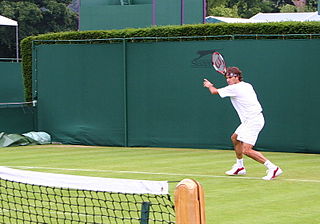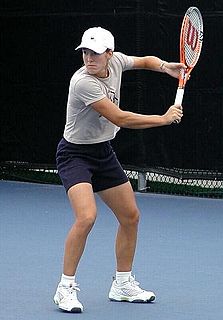
Rodney George Laver, better known as Rod Laver, is an Australian former tennis player. He was the No. 1 ranked professional from 1964 to 1970, spanning four years before and three years after the start of the Open Era in 1968. He also was the No. 1 ranked amateur in 1961–62.

Ricardo Alonso González, usually known as Pancho Gonzales, and sometimes as Richard Gonzales, was an American tennis player who has been rated one of the greatest in the history of the sport. He won 14 major singles titles and was the dominant professional of the 1950s, winning seven professional tours between 1954 and 1961; he still holds the men's all-time record of being ranked world No. 1 for eight years.

Francis "Frank" Arthur Sedgman, is a retired World No. 1 amateur tennis champion. In his 1979 autobiography Jack Kramer, the long-time tennis promoter and player, included Sedgman in his list of the 21 greatest players of all time. Sedgman is one of only five tennis players all-time to win a multiple slam set in two disciplines, matching Margaret Court, Roy Emerson, Martina Navratilova and Serena Williams. In 1951 he and Ken McGregor won the men's doubles Grand Slam. Sedgman turned professional in 1953.

John Albert "Jack" Kramer was an American tennis player of the 1940s and 1950s. A World No. 1 player for a number of years, and one of the most important people in the establishment of modern men's "Open"-era tennis, he was the leading promoter of professional tennis tours in the 1950s and 1960s. He was a relentless advocate for the establishment of Open Tennis between amateur and professional players. An International Tennis Federation (ITF) proposal to introduce Open tennis lost by five votes in 1960, but became a reality in 1968. In 1970, he created the Men's Grand Prix points system. In 1972, he helped found the Association of Tennis Professionals (ATP) with Donald Dell and Cliff Drysdale, and was the first Executive Director. He was unpaid at his request. In that role, he was the leader of an ATP boycott of Wimbledon in 1973, for the banning of Nikola Pilić from the tournament.

Marion Anthony Trabert is a former American World No. 1 tennis champion and long-time tennis author, TV commentator, instructor, and motivational speaker. In his 1979 autobiography Jack Kramer, the long-time tennis promoter and great player himself, included Trabert in his list of the 21 greatest players of all time.
A volley in tennis is a shot in which the ball is struck before it bounces on the ground. Generally a player hits a volley while standing near the net, although it can be executed farther back, in the middle of the tennis court or even near the baseline. The word derives from M. French volée meaning flight.
In tennis, a grip is a way of holding the racquet in order to hit shots during a match. The three most commonly used conventional grips are: the Continental, the Eastern and the Semi-Western. Most players change grips during a match depending on what shot they are hitting.
A half volley in tennis is a shot that is hit immediately after the ball bounces but before it reaches the apex of its bounce. It is sometimes called an "on the rise shot", or "short hop".

The forehand in tennis and other racket sports such as table tennis, squash and badminton is a shot made by swinging the racket across one's body with the hand moving palm-first. In tennis, except in the context of the phrase forehand volley, the term refers to a type of groundstroke—a stroke in which the ball has bounced before it is struck. It contrasts with the backhand, the other type of groundstroke. For a right-handed player, the forehand is a stroke that begins on the right side of the body, continues across the body as contact is made with the ball, and ends on the left side of the body. It is considered the easiest shot to master, perhaps because it is the most natural stroke. Beginners and advanced players often have better forehands than any other shots and use it as a weapon.

The backhand is a tennis shot in which one swings the racquet around one's body with the back of the hand preceding the palm. Except in the phrase backhand volley, the term refers to a groundstroke. It contrasts with the other kind of groundstroke, the forehand. The term is also used in other racquet sports, and other areas where a similar motion is employed.
A groundstroke or ground stroke in tennis is a forehand or backhand shot that is executed after the ball bounces once on the court. It is usually hit from the back of the tennis court, around the baseline.

A lob in tennis is hitting the ball high and deep into the opponent's court. It can be used as an offensive or defensive weapon depending on the situation.

A smash in tennis is a shot that is hit above the hitter's head with a serve-like motion. It is also referred to as an overhead. A smash can usually be hit with a high amount of force and is often a shot that ends the point. Most smashes are hit fairly near the net or in mid-court before the ball bounces, generally against lobs that have not been hit high enough or deep enough by the opponent. A player can also smash a very high ball from the baseline, generally on the bounce, although this is often a less forceful smash.
In tennis, there are a variety of types of shots which can be categorized in various ways. The grip you place on will help you have different types of shots, the lower your grip means that the ball is most likely going to be a ground stroke. According to William T. Tilden, "All tennis strokes, should be made with the body' at right angles to the net, with the shoulders lined up parallel to the line of flight of the ball ." The serve is the opening shot of a point. Groundstrokes are hit after the ball has already bounced, and can be either forehands or backhands depending on which direction the racket is swung relative to the body. A lob is a groundstroke hit well over the head of an opponent who is positioned at the net. A passing shot is a groundstroke that is hit out of reach of an opponent at the net far to his left or right. A cross-court shot is a shot hit from the left side of one player's court to the left side of the other player's court, so that it crosses the lengthwise centerline of the court. A down-the-line shot is one that is hit more or less parallel to, and near to, one of the sidelines, so that it never crosses the centerline.
This page is a glossary of tennis terminology.
Players use different tennis strategies to enhance their own strengths and exploit their opponent's weaknesses in order to gain the advantage and win more points.

Frederick Rudolph "Ted" Schroeder was an American tennis player who won the two most prestigious amateur tennis titles, Wimbledon and the U.S. National. He was the No. 1-ranked American player in 1942; the No. 2 for 4 consecutive years, 1946 through 1949, and the latter year saw Schroeder ranked World No. 1 by Pierre Gillou. He was born in Newark, New Jersey, but developed as a tennis player in Southern California under the guidance of Perry T. Jones.

A passing shot is a forceful shot, as in tennis or team handball, that travels to one side out of the reach of one's opponent. In tennis, this shot is generally a groundstroke and is used when one's opponent is running to the net or if he is at the net already. The alternative to a passing shot is to lob the ball over the opponent's head. The aim of the passing shot in tennis is to prevent the opponent from returning the ball once he/she is at the net.

A serve in tennis is a shot to start a point. A player will hit the ball with a racquet so it will fall into the diagonally opposite service box without being stopped by the net. Normally players begin a serve by tossing the ball into the air and hitting it. The ball can only touch the net on a return and will be considered good if it falls on the opposite side. If the ball contacts the net on the serve but then proceeds to the proper service box, it is called a let; this is not a legal serve in the major tours although it is also not a fault. Players normally serve overhead, however serving underhand is allowed. The serve is the only shot a player can take their time to set up instead of having to react to an opponent's shot. But as of 2012, there is a 25-second limit to be allowed between points.
American tennis player Pancho Gonzales had a long-running rivalry with Australian Ken Rosewall. This rivalry featured some of the greatest matches in tennis history. Gonzales is still sometimes considered to be a candidate for the greatest tennis player of all time; he was the dominant player of the 1950s and still holds the men's all-time record of being ranked world No. 1 for eight years. Rosewall succeeded Gonzales as the world's best player in 1961 and held that position either by himself or sharing it with others for six years. Rosewall was signed in 1956 by the promoter Jack Kramer, a former #1 player himself, to join his small band of touring professionals in 1957. He then engaged in a round-the-world, head-to-head tour against Gonzales, the defending world's champion, over the next five months, winning 26 matches but losing 50. In his 1979 autobiography Kramer included both Gonzales and Rosewall in his list of the 21 greatest players of all time. Kramer, however, initially "panicked" upon signing Rosewall.
He was a cute little fellow with a dink serve, who operated mostly from the baseline. That great volley of his hadn't been developed yet. I was afraid that Gorgo would eat him alive and put us out of business the rest of the way. But like a lot of people I completely underestimated Rosewall.












